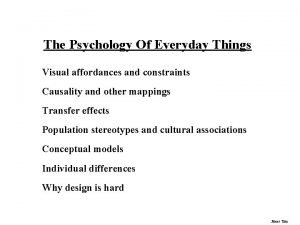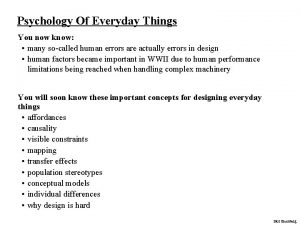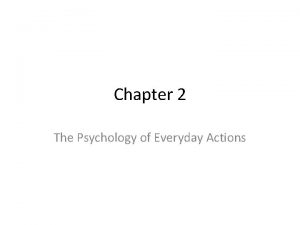Norman Chapter 2 Psychology of Everyday Actions Jeff







- Slides: 7

Norman Chapter 2 Psychology of Everyday Actions Jeff Offutt http: //www. cs. gmu. edu/~offutt/ SWE 205 Software Usability and Design

Making Mistakes • When people make mistakes with UIs, they either: 1. Blame themselves for not paying attention or 2. Blame themselves for being incapable • They seldom blame the UI ! • This is deadly in math, because every subject builds on the previous – Once we fall behind, we think we’re too dumb for math – EVERYbody falls behind sometime 26 -May-21 © Jeff Offutt 2

Growth Mindset • All students fail sometimes – Some come back stronger and more determined Carol Dweck – Some give up Fixed mindset I believe my intelligence and ability to learn is fixed and cannot change Growth mindset I believe that hard work can make me more intelligent and better at learning • Growth habits : Being organized, asking questions, practice, eating well, sleep 26 -May-21 © Jeff Offutt 3

Models Vs. Reality A B Naive guesses are A or B 26 -May-21 C A little physics says that the ball keeps its horizontal motion even after being dropped © Jeff Offutt 4

“Stuff” Happens • If an error is possible, someone will make it • Good UI designers must assume all possible mistakes will happen – Design to minimize the chances of mistakes – Design to minimize the consequences of mistakes – Design to maximize recovery from mistakes Do NOT assume users are perfect 26 -May-21 © Jeff Offutt 5

Helping Users Choose Action 1. Visibility : The user can see the state of the device and how to use it 2. Good conceptual model : The device works the way the users expect 3. Good mappings : Users can see relationships between actions and results, controls and effects, and state and appearance 4. Feedback : The device tells the user what happened at every step 26 -May-21 © Jeff Offutt 6

Summary When something seems easy to use it was probably hard to design 26 -May-21 © Jeff Offutt 7













